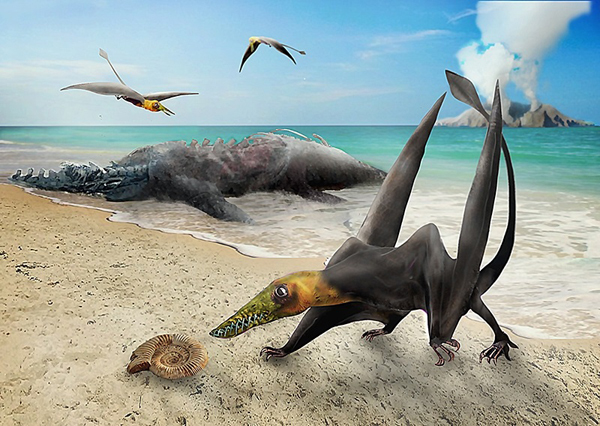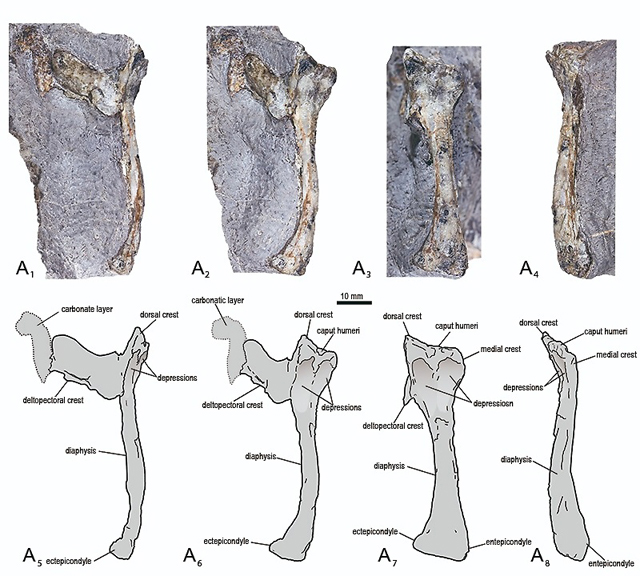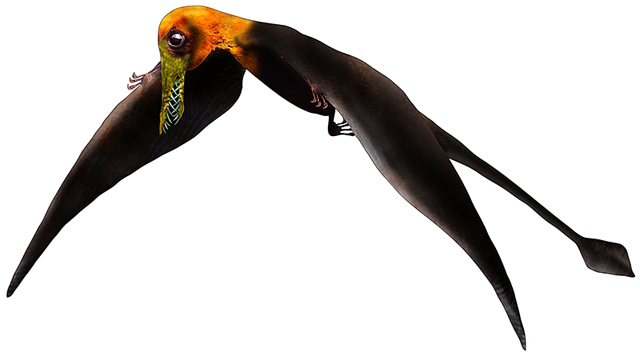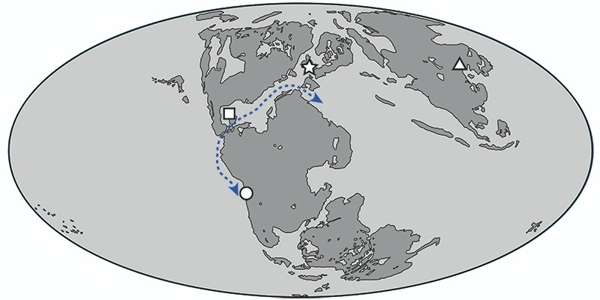The First Record of a Rhamphorhynchid Pterosaur from Gondwana
Fragmentary fossils collected from a location in the Atacama Desert of northern Chile have been assigned to a long-tailed pterosaur, specifically a rhamphorhynchid, this is the first time that evidence for this type of flying reptile has been found in Gondwana and the fossils, which are around 160 million years old, makes this specimen the oldest known pterosaur from Chile.

The Cerro Campamento Formation
The fossil material, consisting of a left humerus (thigh bone), parts of the wing finger and a possible dorsal vertebra, was collected in 2009 from the fossil-bearing Cerro Campamento Formation near the locality of Cerritos Bayos in northern Chile. The bones were all found in the same block and their relative size has led the researchers to believe that all the bones came from a single individual.
The strata in this area have yielded abundant ammonite remains as well as the fossils of numerous marine reptiles and prehistoric fish. Based on the associated ammonite specimens found at this location, the research team are confident that that the pterosaur remains date from the middle Oxfordian age of the Jurassic.

Assigning the Fossils to the Rhamphorhynchidae
Although the remains represent a small proportion of the total skeleton their three-dimensional preservation permitted the research team to confidently assign the material to the Rhamphorhynchidae.
The humerus has a hatchet-shaped deltopectoral crest, proximally positioned, and its shaft is markedly anteriorly curved, which are characteristic features of the Rhamphorhynchidae. Furthermore, the presence of a groove that runs along the caudal surface of the phalanx, being flanked by two asymmetric crests, is a distinctive feature of the clade Rhamphorhynchinae. These traits provide evidence for an affinity to the Rhamphorhynchidae family and as such this reinforces the idea that these types of long-tailed pterosaurs were the first pterosaurs to achieve a relatively global distribution. Writing in the academic journal Acta Palaeontologica Polonica, the researchers who included Jhonatan Alarcón-Muñoz from the Universidad de Chile, assert that the specimen (MUHNCAL.20165), represents the first evidence of this group found to date in Gondwana. They are also the oldest pterosaur fossils to have been described from Chile.
Although it is difficult to estimate the size of the animal, comparisons with the well-known Rhamphorhynchus, most closely associated with the Solnhofen limestone deposits of Bavaria, (southern Germany), indicate that the Chilean pterosaur was large for a rhamphorhynchid. A wingspan in excess of 1.5 to 2 metres has been suggested.

The Caribbean Corridor
Rhamphorhynchid fossils are relatively rare from the Middle Jurassic, but they have been widely reported from Upper Jurassic strata associated with Laurasia. The Chile specimen was found in marine sediments that were deposited at the bottom of a shallow sea, most other rhamphorhynchid fossils are also found in rocks that represent shallow sea, near coastal environments. Some Rhamphorhynchus fossils (R. muensteri) from Solnhofen preserve fish remains as stomach contents and this supports the idea that these pterosaurs were piscivores and lived in coastal habitats.
During the Oxfordian, internal seaways such as the Caribbean corridor and the Trans-Erythrean corridor provided similar coastal environments running down and between Laurasia in the north and Gondwana in the south. The researchers propose that the Caribbean corridor acted as a dispersal route permitting the spread of flying reptiles such as rhamphorhynchids. They postulate that this corridor helps to explain the faunal similarities amongst marine vertebrates found in Germany, the UK, Cuba and South America during the Oxfordian faunal stage.

Map Key
The circle represents the Chile rhamphorhynchid, whilst the square indicates the location of two rhamphorhynchids from Cuba (Cacibupteryx caribensis and Nesodactylus hesperius), the star shape highlights these types of pterosaur discoveries associated with southern England whilst the triangle shows the location of Qinglongopterus guoi from the Tiaojishan Formation of China.
It is likely that more pterosaur fossils will be found in northern Chile. The prospect of further fossil discoveries will hopefully permit palaeontologists to erect a new genus to describe this South American rhamphorhynchid material.
The scientific paper: “First record of a Late Jurassic rhamphorhynchine pterosaur from Gondwana” by J. Alarcón-Muñoz, R. A. Otero, S. Soto-Acuña, A. O. Vargas, J. Rojas and O. Rojas published in Acta Palaeontologica Polonica.
The Everything Dinosaur website: Dinosaur Toys and Models.

